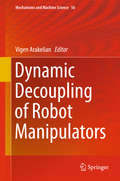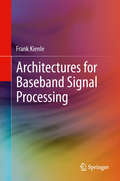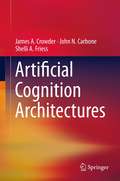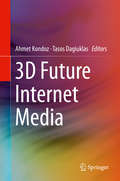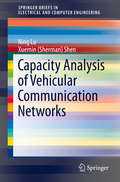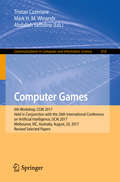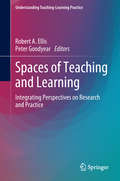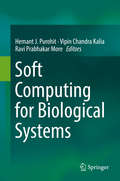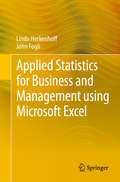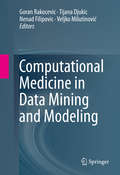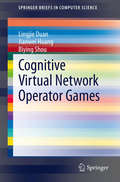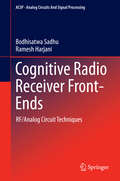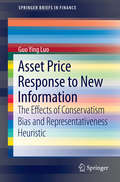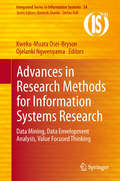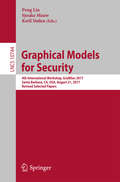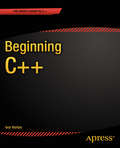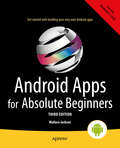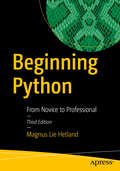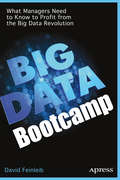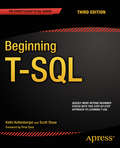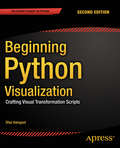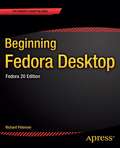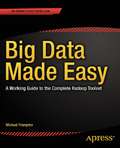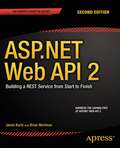- Table View
- List View
Dynamic Decoupling of Robot Manipulators
by Vigen ArakelianThis book presents the latest results in the field of dynamic decoupling of robot manipulators obtained in France, Russia, China and Austria.Manipulator dynamics can be highly coupled and nonlinear. The complicated dynamics result from varying inertia, interactions between the different joints, and nonlinear forces such as Coriolis and centrifugal forces. The dynamic decoupling of robot manipulators allows one to obtain a linear system, i.e. single-input and single output system with constant parameters. This simplifies the optimal control and accumulation of energy in manipulators. There are two ways to create the dynamically decoupled manipulators: via optimal mechanical design or control.This work emphasises mechatronic solutions. These will certainly improve the known design concepts permitting the dynamic decoupling of serial manipulators with a relatively small increase in total mass of the moving links taking into account the changing payload. For the first time such an approach has been applied on serial manipulators. Also of great interest is the dynamic decoupling control of parallel manipulators. Firstly, the dynamic model of redundant multi-axial vibration table with load has been established, and, secondly, its dynamic coupling characteristics have been analyzed. The discussed methods and applications of dynamic decoupling of robot manipulators are illustrated via CAD simulations and experimental tests.
Cell Formation in Industrial Engineering: Theory, Algorithms and Experiments (Springer Optimization and Its Applications #79)
by Panos M. Pardalos Boris Goldengorin Dmitry KrushinskyThis book focuses on a development of optimal, flexible, and efficient models and algorithms for cell formation in group technology. Its main aim is to provide a reliable tool that can be used by managers and engineers to design manufacturing cells based on their own preferences and constraints imposed by a particular manufacturing system. This tool could potentially lower production costs by minimizing other costs in a number of areas, thereby increasing profit in a manufacturing system. In the volume, the cell formation problem is considered in a systematic and formalized way, and several models are proposed, both heuristic and exact. The models are based on general clustering problems, and are flexible enough to allow for various objectives and constraints. The authors also provide results of numerical experiments involving both artificial data from academic papers in the field and real manufacturing data to certify the appropriateness of the models proposed. The book was intended to suit the broadest possible audience, and thus all algorithmic details are given in a detailed description with multiple numerical examples and informal explanations are provided for the theoretical results. In addition to managers and industrial engineers, this book is intended for academic researchers and students. It will also be attractive to many theoreticians, since it addresses many open problems in computer science and bioinformatics.
Architectures for Baseband Signal Processing
by Frank KienleThis book addresses challenges faced by both the algorithm designer and the chip designer, who need to deal with the ongoing increase of algorithmic complexity and required data throughput for today's mobile applications. The focus is on implementation aspects and implementation constraints of individual components that are needed in transceivers for current standards, such as UMTS, LTE, WiMAX and DVB-S2. The application domain is the so called outer receiver, which comprises the channel coding, interleaving stages, modulator, and multiple antenna transmission. Throughout the book, the focus is on advanced algorithms that are actually in use in modern communications systems. Their basic principles are always derived with a focus on the resulting communications and implementation performance. As a result, this book serves as a valuable reference for two, typically disparate audiences in communication systems and hardware design.
Artificial Cognition Architectures
by Shelli Friess John N. Carbone James CrowderThe goal of this book is to establish the foundation, principles, theory, and concepts that are the backbone of real, autonomous Artificial Intelligence. Presented here are some basic human intelligence concepts framed for Artificial Intelligence systems. These include concepts like Metacognition and Metamemory, along with architectural constructs for Artificial Intelligence versions of human brain functions like the prefrontal cortex. Also presented are possible hardware and software architectures that lend themselves to learning, reasoning, and self-evolution
3D Future Internet Media
by Ahmet Kondoz Tasos DagiuklasThis book describes recent innovations in 3D media and technologies, with coverage of 3D media capturing, processing, encoding, and adaptation, networking aspects for 3D Media, and quality of user experience (QoE). The main contributions are based on the results of the FP7 European Projects ROMEO, which focus on new methods for the compression and delivery of 3D multi-view video and spatial audio, as well as the optimization of networking and compression jointly across the Future Internet (www. ict-romeo. eu). The delivery of 3D media to individual users remains a highly challenging problem due to the large amount of data involved, diverse network characteristics and user terminal requirements, as well as the user's context such as their preferences and location. As the number of visual views increases, current systems will struggle to meet the demanding requirements in terms of delivery of constant video quality to both fixed and mobile users. ROMEO will design and develop hybrid-networking solutions that combine the DVB-T2 and DVB-NGH broadcast access network technologies together with a QoE aware Peer-to-Peer (P2P) distribution system that operates over wired and wireless links. Live streaming 3D media needs to be received by collaborating users at the same time or with imperceptible delay to enable them to watch together while exchanging comments as if they were all in the same location. The volume provides state-of-the-art information on 3D multi-view video, spatial audio networking protocols for 3D media, P2P 3D media streaming, and 3D Media delivery across heterogeneous wireless networks among other topics. Graduate students and professionals in electrical engineering and computer science with an interest in 3D Future Internet Media will find this volume to be essential reading.
Capacity Analysis of Vehicular Communication Networks (SpringerBriefs in Electrical and Computer Engineering)
by Ning Lu Xuemin Sherman ShenThis SpringerBrief focuses on the network capacity analysis of VANETs, a key topic as fundamental guidance on design and deployment of VANETs is very limited. Moreover, unique characteristics of VANETs impose distinguished challenges on such an investigation. This SpringerBrief first introduces capacity scaling laws for wireless networks and briefly reviews the prior arts in deriving the capacity of VANETs. It then studies the unicast capacity considering the socialized mobility model of VANETs. With vehicles communicating based on a two-hop relaying scheme, the unicast capacity bound is derived and can be applied to predict the throughput of real-world scenarios of VANETs. The downlink capacity of VANETs is also investigated in which access infrastructure is deployed to provide pervasive Internet access to vehicles. Different alternatives of wireless access infrastructure are considered. A lower bound of downlink capacity is derived for each type of access infrastructure. The last section of this book presents a case study based on a perfect city grid to examine the capacity-cost trade-offs of different deployments since the deployment costs of different access infrastructure are highly variable.
Computer Games
by Tristan Cazenave Mark H.M. Winands Abdallah SaffidineThis book constitutes revised selected papers from the 6th Workshop on Computer Games, CGW 2017, held in conjunction with the 26th International Conference on Artificial Intelligence, IJCAI 2017, in Melbourne, Australia, in August 2017. The 12 full papers presented in this volume were carefully reviewed and selected from 18 submissions. They cover a wide range of topics related to computer games; discussing six abstract games: Chinese Checkers, Chinese Dark Chess, Hex, Othello, Poker, and SameGame.
Spaces of Teaching and Learning
by Peter Goodyear Robert A. EllisThis integrated collection of perspectives on the spaces of teaching and learning uses ‘learning space’ to place educational practice in context. It considers the complex relationships involved in the design, management and use of contemporary learning spaces. It sheds light on some of the problems of connecting the characteristics of spaces to the practices and outcomes of teaching and learning. The contributions show how research into learning spaces can inform broader educational practices and how the practices of teaching, learning and design can inform research. The selection of chapters demonstrates the value of gathering together multiple sources of evidence, viewed through different epistemological lenses in order to push the field forward in a timely fashion. The book provides both a broad review of current practices as well as a deep-dive into particular educational and epistemological challenges that the various approaches adopted entail. Contrasts and commonalities between the different approaches emphasise the importance of developing a broad, robust evidence-base for practice in context. This is the inaugural book in the series Understanding Teaching-Learning Practice.
Soft Computing for Biological Systems
by Vipin Chandra Kalia Hemant J. Purohit Ravi Prabhakar MoreThis book explains how the biological systems and their functions are driven by genetic information stored in the DNA, and their expression driven by different factors. The soft computing approach recognizes the different patterns in DNA sequence and try to assign the biological relevance with available information.The book also focuses on using the soft-computing approach to predict protein-protein interactions, gene expression and networks. The insights from these studies can be used in metagenomic data analysis and predicting artificial neural networks.
Applied Statistics for Business and Management using Microsoft Excel
by Linda Herkenhoff John FogliApplied Business Statistics for Business and Management using Microsoft Excel is the first book to illustrate the capabilities of Microsoft Excel to teach applied statistics effectively. It is a step-by-step exercise-driven guide for students and practitioners who need to master Excel to solve practical statistical problems in industry. If understanding statistics isn't your strongest suit, you are not especially mathematically-inclined, or if you are wary of computers, this is the right book for you. Excel, a widely available computer program for students and managers, is also an effective teaching and learning tool for quantitative analyses in statistics courses. Its powerful computational ability and graphical functions make learning statistics much easier than in years past. However, Applied Business Statistics for Business and Management capitalizes on these improvements by teaching students and practitioners how to apply Excel to statistical techniques necessary in their courses and workplace. Each chapter explains statistical formulas and directs the reader to use Excel commands to solve specific, easy-to-understand business problems. Practice problems are provided at the end of each chapter with their solutions.
Computational Medicine in Data Mining and Modeling
by Veljko Milutinović Goran Rakocevic Tijana Djukic Nenad FilipovicThis book presents an overview of a variety of contemporary statistical, mathematical and computer science techniques which are used to further the knowledge in the medical domain. The authors focus on applying data mining to the medical domain, including mining the sets of clinical data typically found in patient's medical records, image mining, medical mining, data mining and machine learning applied to generic genomic data and more. This work also introduces modeling behavior of cancer cells, multi-scale computational models and simulations of blood flow through vessels by using patient-specific models. The authors cover different imaging techniques used to generate patient-specific models. This is used in computational fluid dynamics software to analyze fluid flow. Case studies are provided at the end of each chapter. Professionals and researchers with quantitative backgrounds will find Computational Medicine in Data Mining and Modeling useful as a reference. Advanced-level students studying computer science, mathematics, statistics and biomedicine will also find this book valuable as a reference or secondary text book.
Cognitive Virtual Network Operator Games (SpringerBriefs in Computer Science)
by Jianwei Huang Lingjie Duan Biying ShouThis SpringerBrief provides an overview of cognitive mobile virtual network operator's (C-MVNO) decisions under investment flexibility, supply uncertainty, and market competition in cognitive radio networks. This is a new research area at the nexus of cognitive radio engineering and microeconomics. The authors focus on an operator's joint spectrum investment and service pricing decisions. The readers will learn how to tradeoff the two flexible investment choices (dynamic spectrum leasing and spectrum sensing) under supply uncertainty. Furthermore, if there is more than one operator, we present analysis of the competition among operators in obtaining spectrum and pricing services to attract users. The brief is designed for professionals working with C-MVNOs. Succinct and practical, it will assist them in making optimal investments and pricing decisions. It will also be of interest to researchers.
Cognitive Radio Receiver Front-Ends: RF/Analog Circuit Techniques (Analog Circuits and Signal Processing #115)
by Bodhisatwa Sadhu Ramesh HarjaniThis book focuses on the architecture and circuit design for cognitive radio receiver front-ends. The authors first provide a holistic explanation of RF circuits for cognitive radio systems. This is followed by an in-depth exploration of existing techniques that can be utilized by circuit designers. Coverage also includes novel circuit techniques and architectures that can be invaluable for designers for cognitive radio systems.
Asset Price Response to New Information: The Effects of Conservatism Bias and Representativeness Heuristic (SpringerBriefs in Finance)
by Guo Ying LuoAsset Price Response to New Information examines the effect of two types of psychological biases (namely, conservatism bias and representativeness heuristic) on the asset price reaction to new information. The author constructs various models of a competitive securities market or a security market allowing for strategic interaction among traders to prove rigorously that either conservatism or representativeness is capable of generating both asset price overreaction and underreaction to new information. The results shed some new insights on the phenomena of the asset price overreaction and underreaction to new information. In the literature, very little has been published in this area of behavioral finance. This volume will appeal to graduate-level students and researchers in finance, behavioral finance, and financial engineering.
Advances in Research Methods for Information Systems Research: Data Mining, Data Envelopment Analysis, Value Focused Thinking (Integrated Series in Information Systems #34)
by Kweku-Muata Osei-Bryson Ojelanki NgwenyamaAdvances in social science research methodologies and data analytic methods are changing the way research in information systems is conducted. New developments in statistical software technologies for data mining (DM) such as regression splines or decision tree induction can be used to assist researchers in systematic post-positivist theory testing and development. Established management science techniques like data envelopment analysis (DEA), and value focused thinking (VFT) can be used in combination with traditional statistical analysis and data mining techniques to more effectively explore behavioral questions in information systems research. As adoption and use of these research methods expand, there is growing need for a resource book to assist doctoral students and advanced researchers in understanding their potential to contribute to a broad range of research problems. Advances in Research Methods for Information Systems Research: Data Mining, Data Envelopment Analysis, Value Focused Thinking focuses on bridging and unifying these three different methodologies in order to bring them together in a unified volume for the information systems community. This book serves as a resource that provides overviews on each method, as well as applications on how they can be employed to address IS research problems. Its goal is to help researchers in their continuous efforts to set the pace for having an appropriate interplay between behavioral research and design science.
Graphical Models for Security: Second International Workshop, Gramsec 2015, Verona, Italy, July 13, 2015, Revised Selected Papers (Lecture Notes in Computer Science #9390)
by Sjouke Mauw Peng Liu Ketil StolenThis book constitutes revised selected papers from the 4th International Workshop on Graphical Models for Security, GraMSec 2017, held in Santa Barbara, CA, USA, in August 2017. The 5 full and 4 short papers presented in this volume were carefully reviewed and selected from 19 submissions. The book also contains one invited paper from the WISER project. The contributions deal with the latest research and developments on graphical models for security.
Beginning C++: Takes Your Step-by-step From Novice To C Programmer (Expert's Voice Ser.)
by Ivor HortonBeginning C++ is a tutorial for beginners in C++ and discusses a subset of C++ that is suitable for beginners. The language syntax corresponds to the C++14 standard. This book is environment neutral and does not presume any specific operating system or program development system. There is no assumption of prior programming knowledge. All language concepts that are explained in the book are illustrated with working program examples. Most chapters include exercises for you to test your knowledge. Code downloads are provided for examples from the text and solutions to the exercises and there is an additional download for a more substantial project for you to try when you have finished the book. This book introduces the elements of the C++ standard library that provide essential support for the language syntax that is discussed. While the Standard Template Library (STL) is not discussed to a significant extent, a few elements from the STL that are important to the notion of modern C++ are introduced and applied. Beginning C++ is based on and supersedes Ivor Horton's previous book, Beginning ANSI C++. What you'll learn How to work with fundamental C++ data types and do calculations How to build logic into a program using loops, choices, decisions and more How to work with arrays, vectors, and strings How to use raw pointers and smart pointers How to program with functions and deal with program files and pre-processing directives How to define your own data types using classes and class operations How to implement operator overloading for your own data types How to apply class inheritance and use virtual functions to obtain polymorphism and errors/exception handling How to signal and handle errors using exceptions How to define and use function templates and class templates How to do file input and output with C++ Who this book is for This book is for industry practitioners and students wanting to learn C++ and use this as a reference guide for their applications. Table of Contents Chapter 1: Basic Ideas Chapter 2: Introducing Fundamental Types of Data Chapter 3: Working Fundamental Types Chapter 4: Making Decisions Chapter 5: Arrays and Loops Chapter 6: Pointers and References Chapter 7: Working with Strings Chapter 8: Defining Functions Chapter 9: Lambda Expressions Chapter 10: Preprocessor directives Chapter 11: Defining your own Data Types Chapter 12: Operator Overloading Chapter 13: Inheritance Chapter 14: Virtual Functions and Polymorphism Chapter 15: Runtime Errors and Exceptions Chapter 16: Class Templates Chapter 17: File Input and Output
Android Apps for Absolute Beginners
by Wallace JacksonAnybody can start building multimedia apps for the Android platform, and this book will show you how Now updated to include both Android 4. 4 and the new Android L, Android Apps for Absolute Beginners, Third Edition takes you through the process of getting your first Android apps up and running using plain English and practical examples. If you have a great idea for an Android app, but have never programmed before, then this book is for you. This book cuts through the fog of jargon and mystery that surrounds Android apps development, and gives you simple, step-by-step instructions to get you started. Teaches Android application development in language anyone can understand, giving you the best possible start in Android developmentProvides simple, step-by-step examples that make learning easy, allowing you to pick up the concepts without fussOffers clear code descriptions and layout so that you can get your apps running as soon as possibleThis book covers both Android 4. 4 (KitKat) and Android L, but is also backwards compatible to cover the previous Android releases since Android 1. 5.
Beginning Python: From Novice to Professional (Novice To Pro Ser.)
by Magnus Lie HetlandGain a fundamental understanding of Python's syntax and features with the second edition of Beginning Python, an up-to-date introduction and practical reference. Covering a wide array of Python-related programming topics, including addressing language internals, database integration, network programming, and web services, you'll be guided by sound development principles. Ten accompanying projects will ensure you can get your hands dirty in no time. Updated to reflect the latest in Python programming paradigms and several of the most crucial features found in Python 3. 0 (otherwise known as Python 3000), advanced topics, such as extending Python and packaging/distributing Python applications, are also covered. What you'll learn Become a proficient Python programmer by following along with a friendly, practical guide to the language's key features Write code faster by learning how to take advantage of advanced features such as magic methods, exceptions, and abstraction Gain insight into modern Python programming paradigms including testing, documentation, packaging, and distribution Learn by following along with ten interesting projects, including a P2P file-sharing application, chat client, video game, remote text editor, and more Complete, downloadable code is provided for each project! Who this book is for Programmers, novice and otherwise, seeking a comprehensive introduction to the Python programming language.
Big Data Bootcamp: What Managers Need to Know to Profit from the Big Data Revolution
by David FeinleibInvestors and technology gurus have called big data one of the most important trends to come along in decades. Big Data Bootcamp explains what big data is and how you can use it in your company to become one of tomorrow's market leaders. Along the way, it explains the very latest technologies, companies, and advancements. Big data holds the keys to delivering better customer service, offering more attractive products, and unlocking innovation. That's why, to remain competitive, every organization should become a big data company. It's also why every manager and technology professional should become knowledgeable about big data and how it is transforming not just their own industries but the global economy. And that knowledge is just what this book delivers. It explains components of big data like Hadoop and NoSQL databases; how big data is compiled, queried, and analyzed; how to create a big data application; and the business sectors ripe for big data-inspired products and services like retail, healthcare, finance, and education. Best of all, your guide is David Feinleib, renowned entrepreneur, venture capitalist, and author of Why Startups Fail. Feinleib's Big Data Landscape, a market map featured and explained in the book, is an industry benchmark that has been viewed more than 150,000 times and is used as a reference by VMWare, Dell, Intel, the U. S. Government Accountability Office, and many other organizations. Feinleib also explains: * Why every businessperson needs to understand the fundamentals of big data or get run over by those who do * How big data differs from traditional database management systems * How to create and run a big data project * The technical details powering the big data revolution Whether you're a Fortune 500 executive or the proprietor of a restaurant or web design studio, Big Data Bootcamp will explain how you can take full advantage of new technologies to transform your company and your career. What you'll learn Which big data technologies are the most compelling and how to get started using them How the intersection of big data, cloud computing, and mobile technologies is opening up huge new markets and opportunities for entrepreneurs and existing businesses alike How to find and put to use valuable data sets How marketers can use big data applications to pinpoint and appeal to the most likely customers How to make much better decisions using big data Who this book is for The target audience for this book is business and IT professionals, investors, managers, entrepreneurs and small business owners, and government officials. Table of Contents Big Data The Big Data Landscape Your Big Data Roadmap Big Data at Work Why a Picture Is Worth a Thousand Words The Intersection of Big Data, Mobile, and Cloud Computing Doing a Big Data Project The Next Billion-Dollar IPO: Big Data Entrepreneurship Reach More Customers with Better Data--and Products How Big Data Is Changing the Way We Live Big Data Opportunities in Education Capstone Case Study: Big Data Meets Romance Big Data Resources
Beginning T-SQL
by Scott Shaw Kathi KellenbergerBeginning T-SQL is a performance-oriented introduction to the T-SQL language underlying the Microsoft SQL Server database engine. T-SQL is essential in writing SQL statements to get data into and out of a database. T-SQL is the foundation for business logic embedded in the database in the form of stored procedures and functions. Beginning T-SQL starts you on the path to mastering T-SQL, with an emphasis on best-practices and sound coding techniques leading to excellent performance. This new edition is updated to cover the essential features of T-SQL found in SQL Server 2014, 2012, and 2008. Beginning T-SQL begins with an introduction to databases, normalization, and to SQL Server Management Studio. Attention is given to Azure SQL Database and how to connect to remote databases in the cloud. Each subsequent chapter teaches an aspect of T-SQL, building on the skills learned in previous chapters. Exercises in most chapters provide an opportunity for the hands-on practice that leads to true learning and distinguishes the competent professional. Important techniques such as windowing functions are covered to help write fast executing queries that solve real business problems. A stand-out feature in this book is that most chapters end with a 'Thinking About Performance' section. These sections cover aspects of query performance relative to the content just presented. They'll help you avoid beginner mistakes by knowing about and thinking about performance from Day 1. Imparts best practices for writing T-SQLHelps you avoid common errorsShows how to write scalable code for good performance
Beginning Python Visualization: Crafting Visual Transformation Scripts
by Shai VaingastWe are visual animals. But before we can see the world in its true splendor, our brains, just like our computers, have to sort and organize raw data, and then transform that data to produce new images of the world. Beginning Python Visualization: Crafting Visual Transformation Scripts, Second Edition discusses turning many types of data sources, big and small, into useful visual data. And, you will learn Python as part of the bargain. In this second edition you'll learn about Spyder, which is a Python IDE with MATLAB(R) -like features. Here and throughout the book, you'll get detailed exposure to the growing IPython project for interactive visualization. In addition, you'll learn about the changes in NumPy and Scipy that have occurred since the first edition. Along the way, you'll get many pointers and a few visual examples. As part of this update, you'll learn about matplotlib in detail; this includes creating 3D graphs and using the basemap package that allows you to render geographical maps. Finally, you'll learn about image processing, annotating, and filtering, as well as how to make movies using Python. This includes learning how to edit/open video files and how to create your own movie, all with Python scripts. Today's big data and computational scientists, financial analysts/engineers and web developers - like you - will find this updated book very relevant.
Beginning Fedora Desktop: Fedora 20 Edition
by Richard PetersenBeginning Fedora Desktop: Fedora 18 Edition is a complete guide to using the Fedora 18 Desktop Linux release as your daily driver for mail, productivity, social networking, and more. Author and Linux expert Richard Petersen delves into the operating system as a whole and offers you a complete treatment of Fedora 18 Desktop installation, configuration, and use. You'll discover how to install Fedora 18 Desktop on any hardware, learn which applications perform which functions, how to managesoftware updates, tips and tricks for the GNOME 3 and KDE desktops, useful shell commands, and both the Fedora administration and network tools. Get the most out of Fedora 18 Desktop -- includingfree Office suites, editors, e-book readers, music and video applications and codecs, email clients, Web and FTP browsers, microblogging and IM applications -- with a copy of Beginning Fedora Desktop: Fedora 18 Edition at your side. "
Big Data Made Easy: A Working Guide to the Complete Hadoop Toolset
by Michael FramptonMany corporations are finding that the size of their data sets are outgrowing the capability of their systems to store and process them. The data is becoming too big to manage and use with traditional tools. The solution: implementing a big data system. As Big Data Made Easy: A Working Guide to the Complete Hadoop Toolset shows, Apache Hadoop offers a scalable, fault-tolerant system for storing and processing data in parallel. It has a very rich toolset that allows for storage (Hadoop), configuration (YARN and ZooKeeper), collection (Nutch and Solr), processing (Storm, Pig, and Map Reduce), scheduling (Oozie), moving (Sqoop and Avro), monitoring (Chukwa, Ambari, and Hue), testing (Big Top), and analysis (Hive). The problem is that the Internet offers IT pros wading into big data many versions of the truth and some outright falsehoods born of ignorance. What is needed is a book just like this one: a wide-ranging but easily understood set of instructions to explain where to get Hadoop tools, what they can do, how to install them, how to configure them, how to integrate them, and how to use them successfully. And you need an expert who has worked in this area for a decade--someone just like author and big data expert Mike Frampton. Big Data Made Easy approaches the problem of managing massive data sets from a systems perspective, and it explains the roles for each project (like architect and tester, for example) and shows how the Hadoop toolset can be used at each system stage. It explains, in an easily understood manner and through numerous examples, how to use each tool. The book also explains the sliding scale of tools available depending upon data size and when and how to use them. Big Data Made Easy shows developers and architects, as well as testers and project managers, how to: Store big dataConfigure big dataProcess big dataSchedule processesMove data among SQL and NoSQL systemsMonitor dataPerform big data analytics Report on big data processes and projectsTest big data systemsBig Data Made Easy also explains the best part, which is that this toolset is free. Anyone can download it and--with the help of this book--start to use it within a day. With the skills this book will teach you under your belt, you will add value to your company or client immediately, not to mention your career.
ASP.NET Web API 2: Building A Rest Service From Start To Finish
by Jamie Kurtz Brian WortmanThe ASP. NET MVC Framework has always been a good platform on which to implement REST-based services, but the introduction of the ASP. NET Web API Framework raised the bar to a whole new level. Now in release version 2. 1, the Web API Framework has evolved into a powerful and refreshingly usable platform. This concise book provides technical background and guidance that will enable you to best use the ASP. NET Web API 2 Framework to build world-class REST services. New content in this edition includes: - New capabilities in Web API 2 (currently version 2. 1). - Support for partial updates, or PATCH. - API versioning. - Support for legacy SOAP-based operations. - How to handle non-resource APIs using REST- How to best expose relationships between resources- JSON Web Tokens, CORS, CSRFGet ready for authors Jamie Kurtz and Brian Wortman to take you from zero to REST service hero in no time at all. No prior experience with ASP. NET Web API is required; all Web API-related concepts are introduced from basic principles and developed to the point where you can use them in a production system. A good working knowledge of C# and the . NET Framework are the only prerequisites to best benefit from this book.
